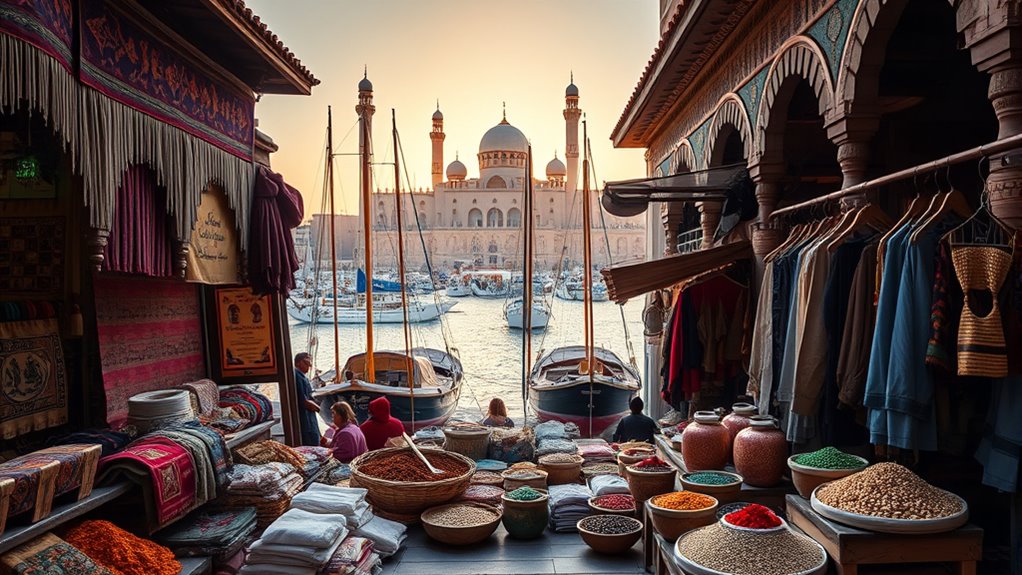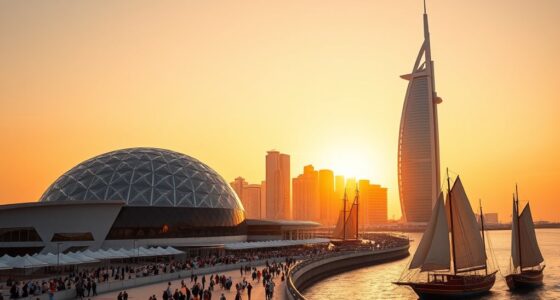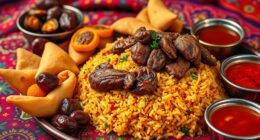Qatar’s history spans over 50,000 years, from ancient settlements and trade routes to modern oil-driven growth. You’ll find influences from the Islamic era, Ottoman presence, and the Al Thani family’s formation of a unified state. Pearl diving and maritime skills shaped its culture, while modern developments blend tradition with skyscrapers and arts. If you explore further, you’ll uncover how Qatar balances its rich heritage with a progressive future.
Key Takeaways
- Qatar’s history dates back 50,000 years, with significant archaeological sites from the Iron Age and influences from Greek, Persian, and Islamic civilizations.
- The Al Thani family unified Qatar in the 18th century, with British influence and oil discovery shaping its modern state.
- Traditional industries like pearl diving and fishing were central to Qatar’s cultural identity before transitioning to oil-based wealth.
- Qatar’s cultural heritage includes crafts like weaving and spear-making, reflecting Bedouin traditions, Islamic art, and maritime history.
- Today, Qatar blends its rich history with modern architecture, arts, and global events, fostering a unique cultural identity rooted in tradition and innovation.
Ancient Beginnings and Early Settlements
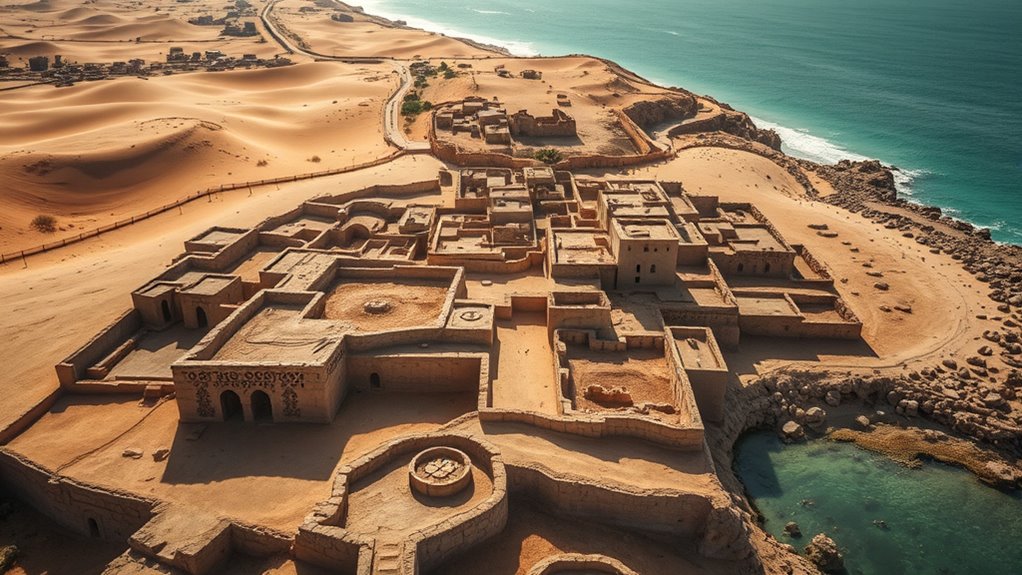
Human occupation in Qatar dates back approximately 50,000 years, making it one of the most ancient inhabited regions in the Arabian Peninsula. You can see evidence of early humans through archaeological finds, like stone tools and burial sites. During the Iron Age, around 300 BCE to 300 CE, over 5,000 stone burial mounds appeared near the west coast, despite harsh climate conditions. You might also notice Greek historian Herodotus’ description of the early inhabitants as “sea-faring Canaanites,” highlighting their maritime skills. Hellenistic influences from the Seleucid Empire brought Greek-style pottery and large burial cairns, indicating a thriving community. During this period, regional trade flourished, as evidenced by fish-processing complexes from the Graeco-Roman era, showing Qatar’s role in ancient commerce. Ancient trade networks played a significant role in shaping the development of early societies in the region.
Influences of the Islamic and Medieval Eras

During the Islamic and medieval periods, Qatar’s strategic location and natural resources made it a vital center for trade, agriculture, and cultural exchange. You see, it thrived as a major hub for pearl trading, attracting merchants from Persia, India, and beyond. The region also became known for horse and camel breeding, enhancing its reputation in regional commerce. Archaeological sites reveal prosperous communities, with stone houses, mosques, and forts built during this time. Artifacts from China, West Africa, and Thailand highlight Qatar’s extensive trade links. Under various rulers, including the Umayyads, Abbasids, and local sheikhdoms, the area absorbed Islamic cultural influences, shaping its religious practices, architecture, and societal structures. These medieval influences laid a foundation for Qatar’s evolving identity. Additionally, the adoption of Islamic art and architecture played a significant role in defining the nation’s cultural landscape during this period.
Ottoman Rule and Regional Dynamics

As regional powers vied for control over the Gulf, the Ottoman Empire extended its influence into Qatar in the late 19th century, shaping its political landscape. You’ll find that Ottoman authorities tried to establish administrative control, but local tribal sheikhs, especially the Al Thani, maintained significant independence. Ottoman officials appointed governors and stationed troops, yet their authority often clashed with tribal loyalties and regional interests. Resistance from tribes, combined with European colonial ambitions, complicated Ottoman efforts to exert full control. During this period, Qatar’s strategic location made it a key piece in regional power struggles. The Ottomans’ presence influenced local governance, military organization, and trade networks, setting the stage for future conflicts and the gradual emergence of a distinct Qatari identity separate from Ottoman dominance. Notably, the Ottoman attempts at asserting authority often conflicted with the tribal loyalties that played a crucial role in shaping Qatar’s social and political fabric.
Foundations of the Modern State
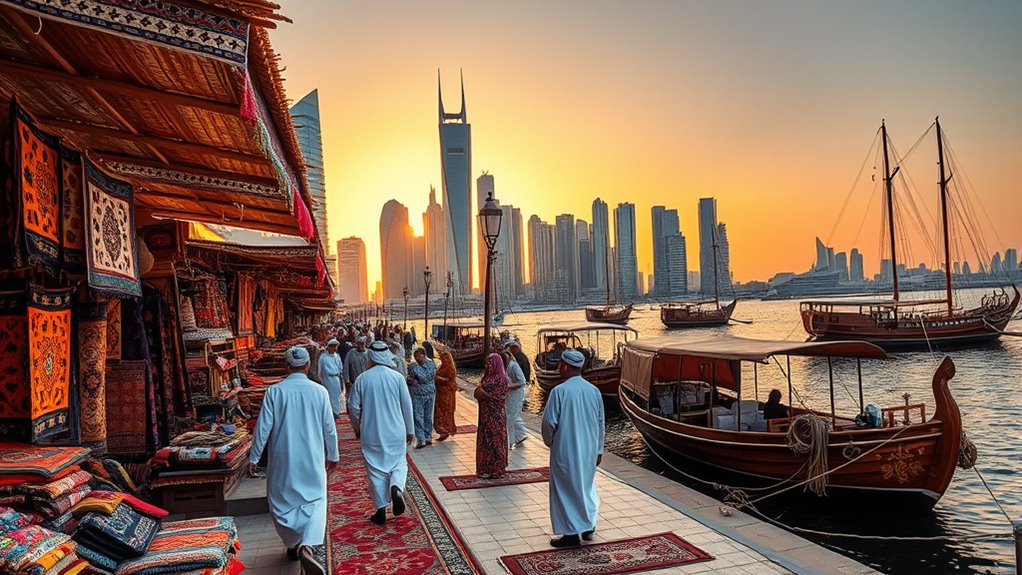
How did Qatar transform from a collection of tribal territories into a modern state? It began with the Al Thani family uniting local tribes around 1766, establishing a centralized leadership. In the 19th century, Britain’s influence grew, culminating in treaties that defined Qatar’s external relations and provided security. By 1916, Qatar became a British protectorate, which helped stabilize the region but limited sovereignty. The discovery of oil in 1939 shifted the economic focus from pearling to hydrocarbons, fueling modernization. After Britain announced its withdrawal in 1968, Qatar declared independence in 1971, establishing its own government. The formation of a constitution and regional alliances like the Gulf Cooperation Council laid the groundwork for a sovereign, progressive state rooted in tribal leadership and strategic diplomacy. Additionally, the development of Cold-Pressed Vegetable Juices and other health trends reflects Qatar’s embrace of modern, health-conscious lifestyles.
Path to Independence and Political Development

You see how colonial powers influenced Qatar’s journey toward independence, shaping its political landscape and regional relations. As the Al Thani family consolidated power, they laid the groundwork for nationhood through leadership and political unity. When Britain announced its withdrawal, Qatar seized the opportunity to establish sovereignty and define its place in the region. This period also marked the development of dynamic diplomatic relations, which continue to play a crucial role in Qatar’s international standing.
Colonial Influence and Sovereignty
The path to Qatar’s independence was shaped considerably by colonial influence, particularly through British strategic interests in the Gulf region. You see, Britain sought to secure trade routes and establish military footholds, which led to treaties that limited Qatar’s sovereignty. These agreements kept Qatar under British protection but constrained its political freedom. Over time, local leaders, especially the Al Thani family, began to push for greater independence. The struggle culminated in Qatar’s official declaration of independence in 1971, ending colonial dominance. Colonial treaties played a crucial role in shaping Qatar’s political landscape during this period.
Political Consolidation and Leadership
Political consolidation in Qatar gained momentum as local leaders, particularly the Al Thani family, worked to unify the tribes and establish a strong central authority. They gradually gained control, consolidating power through alliances and strategic negotiations. This process laid the groundwork for independence, with the Al Thani family becoming the dominant ruling entity. As external influences grew, especially from Britain, Qatar’s leadership adapted, balancing tribal interests with diplomatic relations. The signing of treaties in the 19th century formalized Qatar’s status, while internal stability increased. By the 20th century, Qatar’s leadership had established a structured government, paving the way for independence in 1971. Their efforts guaranteed political stability, enabling Qatar to transition from a tribal society to a modern state. Building a reliable infrastructure was essential in supporting this political development and modernization process.
Economic Transformation: From Pearls to Oil
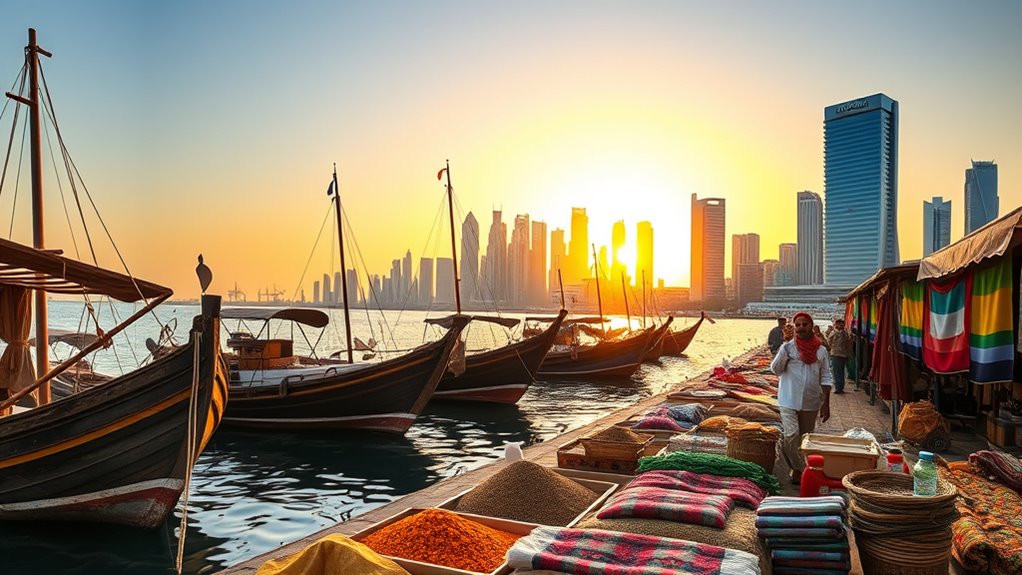
You see, Qatar’s once-thriving pearl industry declined sharply in the early 20th century due to overharvesting and the rise of synthetic alternatives. As the pearl trade waned, oil discoveries in the 1930s and beyond transformed the economy, turning Qatar into a major hydrocarbon producer. This shift reshaped the nation’s wealth and development, setting the stage for its modern growth.
Pearl Industry Decline
As the 20th century progressed, Qatar’s economy shifted dramatically from reliance on the pearl industry to oil production, fundamentally transforming the nation’s economic landscape. The decline of pearl diving hit hard, as natural causes and the advent of cultured pearls made traditional methods obsolete. You’d feel the loss as livelihoods disappeared and communities faced economic hardship. The once-thriving pearl ports grew silent, and Qatari society had to adapt quickly. This shift prompted a sense of uncertainty and urgency to find new sources of wealth. The increasing influence of oil industry development further accelerated this economic transition, reshaping Qatar’s future.
- Communities mourned a fading way of life, their heritage slipping away
- Families faced economic hardship, struggling to sustain their traditions
- The vibrant pearl markets faded into memory, replaced by a new era
- A nation braced itself for inevitable change and renewal
Oil Economy Rise
The discovery of oil in Qatar in the 1930s marked a turning point that rapidly transformed the nation’s economy. Suddenly, you shift from a reliance on pearling and fishing to becoming a hydrocarbon hub. Oil revenues fund infrastructure, education, and healthcare, propelling Qatar into modernity. This economic boost attracts foreign investment, diversifying industries. The country’s wealth grows, enabling you to develop a global presence through sports, culture, and diplomacy. As oil production increases, Qatar’s strategic position becomes essential for regional stability. This transformation from a traditional economy to an oil-based one reshapes society and governance, laying the groundwork for future prosperity. Resources and Tools can provide further insights into the economic development process.
Cultural Heritage and Traditional Crafts
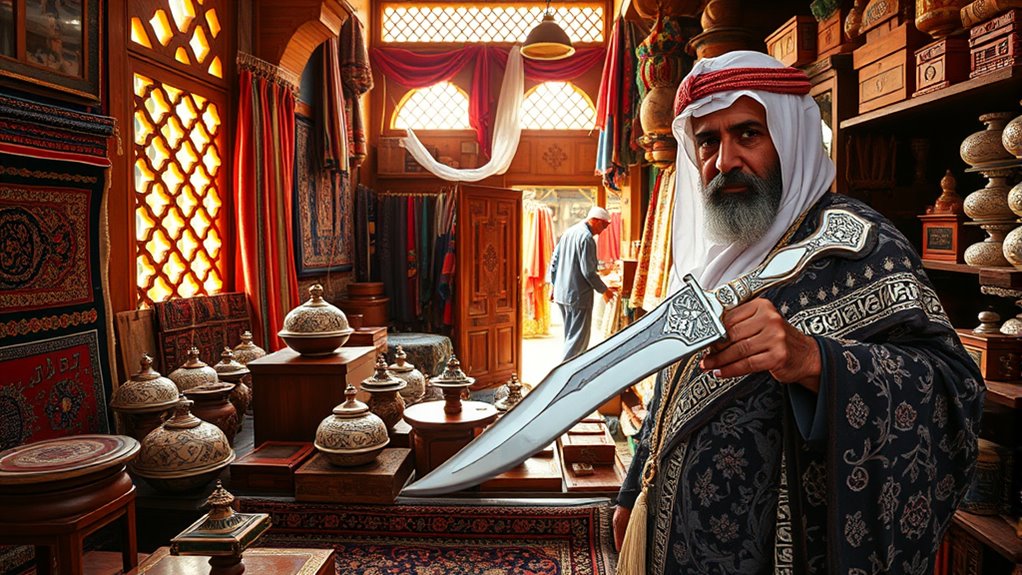
Qatar’s cultural heritage is deeply rooted in its Bedouin traditions, Islamic faith, and maritime history. You can see this in the traditional crafts that have been passed down through generations. Weaving is a cherished skill, especially creating striped cloaks and textiles that tell stories of your ancestors. Spear-making reflects your community’s hunting and defense skills, showcasing artisanal mastery. Pearl diving, once a crucial industry, shaped your cultural identity and trade practices. These crafts evoke pride and connect you to your history, reminding you of a time when your people thrived through resourcefulness and craftsmanship. Preserving these traditions allows you to honor your past while sharing your unique cultural story with the world. Cultural preservation ensures that these skills and stories continue to inspire future generations.
Modernization and Contemporary Cultural Identity

Modernization has transformed Qatar from a society rooted in traditional crafts and maritime skills into a dynamic nation embracing global influences. You now see a country where sleek skyscrapers stand alongside ancient souks, reflecting a blend of tradition and progress. Education and arts have flourished, with museums and cultural festivals celebrating Qatar’s heritage while promoting contemporary creativity. The government actively promotes a national identity that honors Bedouin roots, Islamic traditions, and modern innovation. You’ll notice this balance in Qatar’s sports, architecture, and arts scenes, which showcase both local pride and international engagement. As Qatar prepares for global events like the FIFA World Cup, its cultural identity evolves, emphasizing hospitality, tolerance, and a forward-looking vision rooted in its rich history.
Frequently Asked Questions
What Are Qatar’s Most Significant Archaeological Sites Today?
You should visit Qatar’s most significant archaeological sites like Murwab, where you’ll find stone houses, mosques, and a fort from the 9th century, showcasing early prosperity. The over 50,000-year-old human occupation sites reveal ancient habitation, while the stone burial mounds from the Iron Age highlight regional trade and cultural influences. These sites offer a fascinating glimpse into Qatar’s rich history, connecting you to its early settlements and maritime traditions.
How Did Trade Influence Qatar’s Ancient Cultural Development?
Trade shaped Qatar’s ancient culture by bringing in diverse goods, ideas, and influences from China, West Africa, and Thailand. You’d see artifacts from these regions at archaeological sites, showing how trade connected Qatar to a wider world. This exchange helped develop local craftsmanship, like pottery and jewelry, and fostered a cosmopolitan outlook. As a result, trade played a key role in enriching Qatar’s cultural identity and regional importance over centuries.
What Role Did Tribal Alliances Play in Qatar’s Political History?
You should know that tribal alliances have been vital in shaping Qatar’s political history. Around 1766, the Al Thani family united local tribes, establishing dominance that persists today. These alliances helped tribes resist external threats and maintain control over key regions. By forming strategic partnerships, Qatar’s tribes stabilized power, navigated regional conflicts, and laid the groundwork for modern statehood—demonstrating the enduring importance of tribal unity in its political development.
How Has Qatar Preserved Its Traditional Crafts Amid Modernization?
You can see Qatar’s dedication to preserving traditional crafts through its museums, cultural festivals, and artisan workshops. They actively promote skills like weaving striped cloaks and spear-making, passing techniques from generation to generation. Despite rapid modernization, Qatar values its artisanal heritage, ensuring these crafts remain vibrant. You might participate in craft demonstrations or buy handcrafted items, helping sustain these cultural traditions amid the country’s evolving landscape.
What Are Major Cultural Festivals Celebrating Qatar’s Heritage?
You’ll find Qatar’s cultural festivals beautifully celebrating its rich heritage, blending tradition with modern vibrancy. Events like the Qatar National Day, showcasing patriotic pride and traditional performances, or the Souq Waqif Arts Festival, highlighting local crafts and music, invite you to experience the nation’s soul. These festivals serve as heartfelt gatherings where the timeless spirit of Qatar’s Bedouin roots and maritime legacy are honored, ensuring their enduring legacy.
Conclusion
As you explore Qatar’s rich history and culture, you’ll see how its journey from ancient settlements to a modern nation is truly remarkable. Did you know that Qatar’s GDP per capita surpassed $60,000 in 2022, making it one of the wealthiest countries globally? This economic strength supports its vibrant cultural scene, blending tradition with innovation. By understanding its past, you gain a deeper appreciation for Qatar’s unique identity and bright future.

